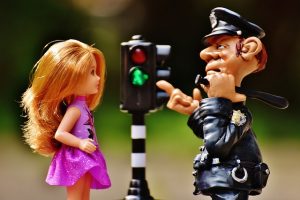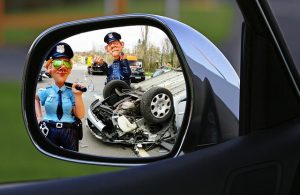I get it. The grammar police can be annoying when they continually correct your grammar. But do you know what’s even more annoying?
This:

If you recognize the grammar error in this sign, good for you! The grammar police won’t be handing you a citation this time.
If you don’t recognize the error, the grammar police have officially given you a warning citation. Don’t worry—you can avoid paying any fines by reading this post and learning to recognize this and nine other common grammar mistakes.
Avoid These 10 Common Grammar Mistakes in Your Paper
I’m sure there are about a bajillion grammar errors you might make in any given paper, but I can’t cover them all in this post. Instead, let’s focus on 10 common grammar mistakes that will help keep the grammar police at bay.
Easily confused words
Some words sound almost the same and are spelled similarly, so it can be easy to get them mixed up. Here are five sets of words that are easily confused.
1. Then/Than
- Then generally refers to actions in time.
Example #1: If you don’t finish your paper, then you might fail the course.
Example #2: Emily went to the food court, then headed to the movies.
- Than is a comparison.
Example #1: John’s car is better than Carl’s.
Example #2: I’d rather enroll in calculus than physics.
2. Effect/Affect
- Effect means a result.
Example #1: Sunshine can have a great effect on people’s moods.
Example #2: Did the experiment demonstrate an effect on climate change?
- Affect means to influence.
Example #1: The speakers remarks didn’t affect her opinion.
Example #2: Eating dessert first never affects my appetite.
3. They’re/Their
- They’re is a contraction for “they are.”
Example #1: They’re going to the concert on Saturday.
Example #2: I hope they’re learning how to avoid grammar mistakes.
- Their shows possession or ownership.
Example #1: The children wanted their books stacked in the corner.
Example #2: The students hoped their tests would be graded on a curve.
4. Your/You’re
- Your shows possession or ownership.
Example #1: Where are your car keys?
Example #2: Lara left her books in your room.
- You’re is a contraction for “you are.”
Example #1: I heard that you’re going on vacation in July.
Example #2: Are you sure you’re driving in the right direction?
5. Its/It’s
- Its shows possession or ownership.
Example #1: The dog chased its tail.
Example #2: The leopard changed its spots.
- It’s is a contraction for “it is.”
Example #1: It’s time to board the plane.
Example #2: Lauren said it’s vital to keep the dog away from the crazy cat.
We all know the English language has a seemingly infinite number of confusing words, so if there are a few words that still confuse you, check out this list of easily confused words.
Feel like you’ve mastered all those confusing words but feel the grammar police are ready to fine you heavily for making unnecessary sentence errors? Fear no more. Here are a few tips to help with common grammar errors related to sentence structure.
Sentence errors
6. Comma splice
A comma splice incorrectly separates two or more complete sentences with a comma.
Example: I watched movies all night, I was tired the next morning.
This sentence is a comma splice because “I watched movies all night” and “I was tired the next morning” are both complete sentences and are joined incorrectly by a comma.
7. Run-on sentence
A run-on sentence incorrectly joins two or more complete sentences without any form of punctuation.
Example: The line at the concession was long so we decided not to wait.
This sentence is a run-on sentence because “The line at the concession was long” and “we didn’t want to wait” are both complete sentences but are not joined by proper punctuation. (They are instead joined incorrectly by the conjunction “so.”)
8. Sentence fragment
A sentence fragment is an incomplete sentence that’s missing a subject, a verb, or a complete thought.
Example: Stayed at the hotel.
This sentence is missing a subject, which makes it a sentence fragment.
Correcting sentence errors
Correct sentence fragments by making sure that all sentences have a subject, a verb, and a complete thought.
Correct comma splices and run-on sentences by using the following strategies.
Create two complete sentences by adding a period:
The car wouldn’t start, the battery was dead. (comma splice)
The car wouldn’t start. The battery was dead.
Correctly join the two sentences by adding a semi-colon:
Jayden and Gabriella got married Saturday it was a beautiful ceremony. (run-on sentence)
Jayden and Gabriella got married Saturday; it was a beautiful ceremony.
Make one of the sentences a dependent clause:
We went outside, we realized it was raining. (comma splice)
When we went outside, we realized it was raining.
Connect two complete sentences by adding a comma and a coordinating conjunction (also known as FANBOYS–for, an, nor, but, or, yet, so):
Sophia called me but I didn’t feel like answering her call. (run-on sentence)
Sophia called me, but I didn’t feel like answering her call.
Still feeling a little nervous? Worried that a member of the grammar police will catch you off guard and find out you’re still confused about apostrophes? Check out these tips on common grammar mistakes with apostrophes.
Apostrophe errors
Apostrophes are most often used in two instances:
- To form contractions
- To show possession
Apostrophe tip: NEVER use an apostrophe to make words plural (that includes when using acronyms!).
Ari ordered five pizza’s for the party.
Ari ordered five pizzas for the party.
9. Contractions
An apostrophe can be used to indicate that letters have been omitted in a contraction. The apostrophe takes the place of the omitted letters.
Examples:
- Don’t (Do not)
- Can’t (Cannot or can not, depending on your intended meaning)
- Won’t (Will not)
- I’m (I am)
- Should’ve (Should have)
NOTE: Should’ve, could’ve, and would’ve are grammatically correct. “Could of,” “would of,” and “should of” are not grammatically correct and should never be used.
10. Possession
An apostrophe can be used to show possession or ownership.
Example #1: the woman’s scarf (the scarf belongs to the woman)
Example #2: the boy’s action figures (the action figures belong to the boy)
Leave the Grammar Police in the Rear-view Mirror
Now that you know how to avoid 10 common grammar mistakes, you can leave the grammar police in the dust…but only if you can recognize the error that I included at the beginning of the post.
Did you recognize the apostrophe error? Did you notice that the apostrophe is used incorrectly because it makes “Mom’s” and “Dad’s” possessive? In this case, both “Moms” and “Dads” should be plural. (No apostrophe is needed.)
Looking for a few more grammar and writing style tips? Read these articles:
- Dangling Modifier: Don’t Make This Funny Grammar Mistake
- 7 Grammar Rules That Everyone Should Learn
- 3 Ways to Focus on Concrete Language in Your Next Essay
- Why Eliminating Wordiness is So Important for Your Essay
Want to test your grammar skills on a few sample papers? See if you can spot any errors in our sample essays.
Still not sure if your paper is grammatically correct? Let the grammar police at Kibin make sure your paper is free of any grammar offenses. (Don’t forget: We can help with more than just grammar, so let us provide help with content and style too!)



